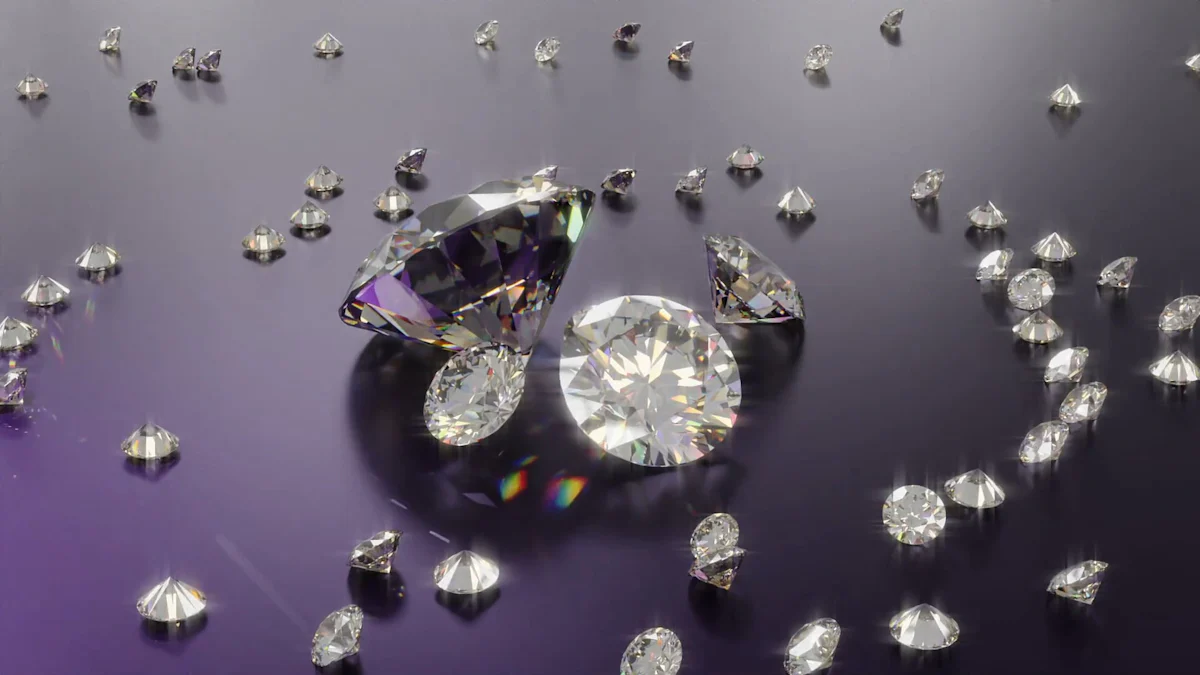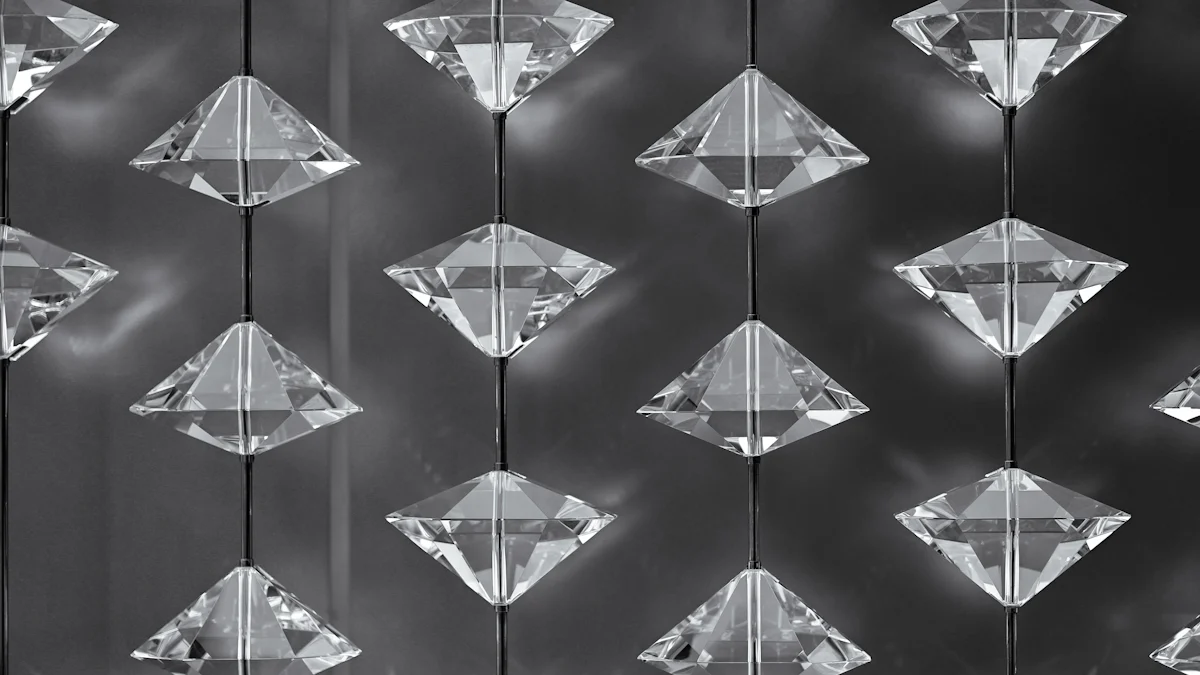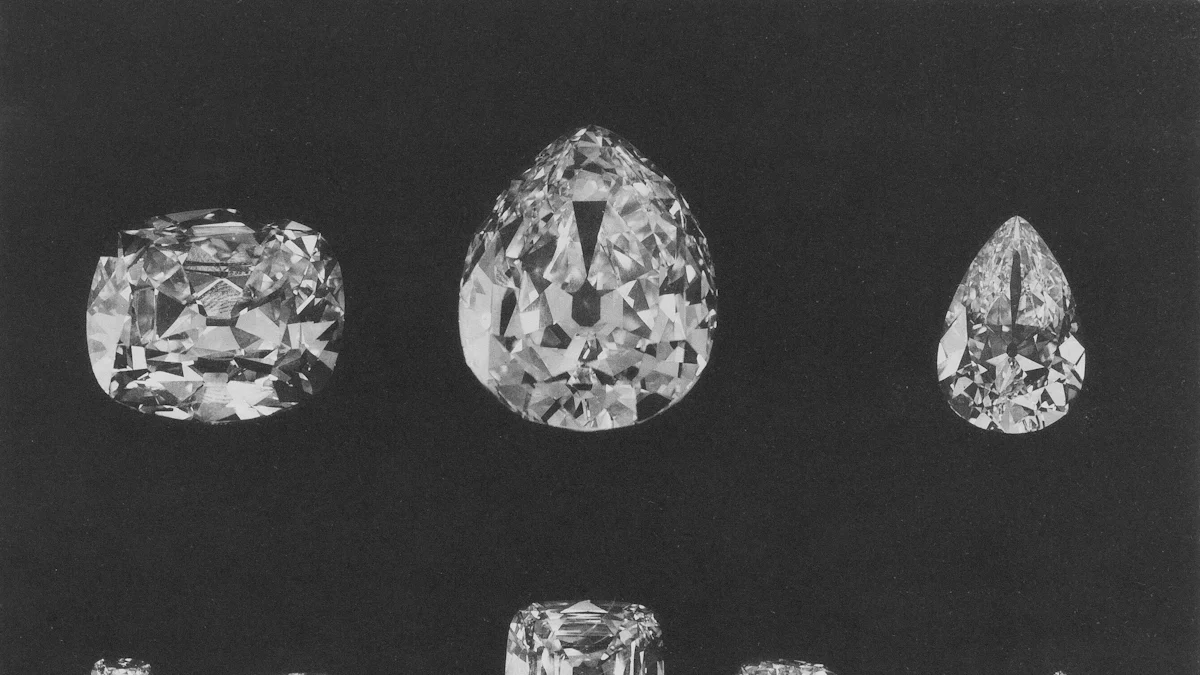What Is TW Diamond and How It Differs

When exploring diamond jewelry, you may encounter terms like "what is t w diamond" and "cttw." These terms hold significant importance in understanding the value of a piece. TW, or Total Weight, refers to the combined weight of all diamonds in a jewelry item. On the other hand, CTTW, or Carat Total Weight, measures the total carat weight of all diamonds present. Knowing these distinctions helps you evaluate not just the size but also the quality of the diamonds. As one gemologist noted, "CTTW is a crucial player in assessing the value of diamond jewelry."
What Is TW in Diamond Jewelry?

Definition of TW
TW, or Total Weight, represents the combined weight of all diamonds in a piece of jewelry. This measurement includes every diamond, whether large or small, that contributes to the design. For example, if a ring features a central diamond surrounded by smaller accent stones, TW accounts for the weight of all these diamonds together. Unlike focusing on a single diamond, TW provides a broader perspective on the overall weight of the diamonds in the jewelry.
Significance of TW in Jewelry
Understanding TW helps you evaluate the overall value and appearance of diamond jewelry. A higher TW often indicates a more substantial and visually impactful piece. However, TW does not reflect the size or quality of individual diamonds. For instance, two pieces of jewelry with the same TW might look different due to variations in diamond size, cut, or arrangement. Knowing this term ensures you can make informed decisions when comparing jewelry options.
Examples of TW in Diamond Jewelry
TW plays a crucial role in many popular jewelry designs. For instance:
- Adiamor Diamond Halo Earrings: These earrings feature 36 small diamonds with a total weight of 0.20 carats, combined with a 1-carat center stone. The TW of this piece is 1.20 carats, showcasing its brilliance and elegance.
- Blue Nile Pavé Engagement Ring: This engagement ring includes smaller pavé-set diamonds with a TW of 0.50 carats, paired with a central diamond weighing 0.50 carats. Together, the TW reaches 1.00 carat, offering a balanced and sophisticated design.
- Whiteflash Engagement Ring: This ring combines a 1-carat center diamond with smaller accent diamonds totaling 0.50 carats. The TW of 1.50 carats highlights the ring's luxurious appeal.
These examples demonstrate how TW reflects the combined weight of all diamonds in a piece, helping you assess its overall impact and value.
What Is CTTW in Diamond Jewelry?
Definition of CTTW (Total Carat Weight)
CTTW, or Carat Total Weight, represents the combined carat weight of all diamonds in a piece of jewelry. This term provides a clear measurement of the total weight of diamonds, whether the jewelry contains a single diamond or multiple stones. For example, if a ring features a 1-carat center diamond and smaller accent diamonds weighing 0.50 carats, the CTTW of the ring would be 1.50 carats. Unlike TW, which focuses on the overall weight, CTTW specifically measures the carat weight of diamonds, offering a more precise understanding of their size and value.
Importance of CTTW for Buyers
Understanding CTTW is essential when evaluating diamond jewelry. It helps you determine the overall size and presence of the diamonds in a piece. A higher CTTW often indicates a more striking and luxurious design. However, CTTW does not account for the quality of the diamonds, such as their cut, clarity, or color. For instance, two rings with the same total carat weight of 1.0 carat may differ significantly in appearance and price due to variations in diamond quality. Knowing the CTTW allows you to assess whether a piece aligns with your preferences and budget.
Examples of CTTW in Diamond Jewelry
CTTW plays a vital role in showcasing the brilliance and elegance of various jewelry designs. Here are some examples:
- Adiamor Diamond Halo Earrings: These earrings feature 36 small diamonds totaling 0.20 carats, paired with a 1-carat center stone. The CTTW of this piece is 1.20 carats, creating a dazzling and sophisticated look.
- Whiteflash Engagement Ring: This ring combines a 1-carat center diamond with smaller accent diamonds weighing 0.50 carats. The total carat weight of this ring is 1.50 carats, highlighting its luxurious appeal.
- Blue Nile Solitaire Setting: A solitaire ring from Blue Nile with a 1-carat diamond has a CTTW of 1.00 carat. Alternatively, a halo pendant featuring a 1-carat center stone and smaller diamonds totaling 0.51 carats offers a total carat weight of 1.51 carats, blending elegance with affordability.
- 1/4 CTTW Diamond Jewelry: Jewelry with a CTTW of 0.25 carats, such as a lotus basket pavé engagement ring, includes small diamonds that collectively weigh one-quarter of a carat. This option balances sparkle and cost, making it ideal for those seeking subtle brilliance.
These examples illustrate how CTTW provides valuable insights into the size and composition of diamonds in jewelry. By understanding this term, you can make informed decisions and select pieces that meet your expectations.
Key Differences Between TW and CTTW

Meaning and Measurement
The terms TW and CTTW may seem similar, but their meanings and measurements differ significantly. TW, or total weight of all diamonds, refers to the combined weight of every diamond in a jewelry piece. This includes both the main diamond and any smaller accent stones. On the other hand, CTTW, or total carat weight, specifically measures the carat total weight of all diamonds in the jewelry. While TW provides a general idea of the overall weight, CTTW focuses on the precise carat measurement.
For example, if a ring features a 1-carat center diamond and smaller diamonds weighing 0.50 carats, the CTTW number would be 1.50 carats. TW, however, might include additional elements like the setting, which could slightly alter the total weight. Understanding these distinctions ensures you can accurately assess the size and value of the diamonds in your jewelry.
Usage in Jewelry Descriptions
Jewelry descriptions often use TW and CTTW to highlight the weight of diamonds, but they serve different purposes. TW is commonly used to describe the total weight of all diamonds in a piece, including the weight of the center stone and any smaller diamonds. For instance, a necklace with multiple diamonds might list its TW to give you an idea of its overall heft and presence.
CTTW, however, is more precise and focuses solely on the total carat weight of the diamonds. This term is especially important when comparing pieces with similar designs. For example, two rings might have the same TW, but their CTTW could differ due to variations in the size or arrangement of the diamonds. By paying attention to these terms, you can better understand what the jewelry offers and how it aligns with your preferences.
Buyer Considerations
When purchasing diamond jewelry, understanding TW and CTTW helps you make informed decisions. TW gives you a sense of the overall weight of the piece, but it doesn’t provide details about the individual diamonds. CTTW, on the other hand, focuses on the total carat weight, allowing you to evaluate the size and value of the diamonds more accurately.
As a buyer, you should also consider the weight of the center stone and how it contributes to the overall design. A higher CTTW number often indicates a more luxurious piece, but it’s essential to assess the quality of the diamonds as well. Two pieces with the same CTTW might differ significantly in price and appearance due to differences in cut, clarity, and color. Always ask for clarity on these terms to ensure you’re getting the best value for your investment.
Why Understanding These Terms Matters
Impact on Diamond Quality
Understanding terms like cttw and total weight directly affects how you evaluate diamond quality. These measurements provide insight into the size and weight of the diamonds in a piece of jewelry. However, they do not account for other critical factors like cut, clarity, and color. For example, two rings with the same cttw may look entirely different because one features poorly cut diamonds while the other uses expertly crafted stones. By knowing these terms, you can focus on both the weight and the inherent quality of the diamonds, ensuring you select pieces that meet your expectations.
"CTTW is an integral part of diamond weighing and price determination," as experts often emphasize. This highlights its role in assessing the overall value of a jewelry item.
When you understand these terms, you gain the ability to compare jewelry more effectively. You can identify whether a piece offers true value or simply relies on the weight of lower-quality diamonds to appear impressive.
Impact on Pricing
The pricing of diamond jewelry heavily depends on cttw and the quality of the diamonds. A higher cttw often leads to a higher price, but this does not always mean better value. For instance, a necklace with a cttw of 2.0 carats might cost less than another with the same cttw if the latter features diamonds with superior clarity and color. Knowing the difference between cttw and total weight helps you understand what you are paying for.
Retailers often use these terms in descriptions to justify pricing. By understanding them, you can ask the right questions about the diamonds' quality and ensure the price aligns with the piece's actual value. This knowledge empowers you to avoid overpaying for jewelry that may not meet your standards.
Making Informed Purchasing Decisions
When you grasp the meaning of cttw and total weight, you make smarter purchasing decisions. These terms guide you in evaluating the size, weight, and overall appeal of diamond jewelry. They also help you navigate the market confidently, ensuring you choose pieces that balance beauty and value.
To make informed choices, always consider the following:
- Ask for clarity: Confirm whether the listed weight refers to cttw or total weight.
- Examine quality: Look beyond weight and assess the diamonds' cut, clarity, and color.
- Compare options: Use your understanding of these terms to evaluate similar pieces and find the best fit for your preferences and budget.
By applying this knowledge, you can select jewelry that not only looks stunning but also holds lasting value.
Understanding TW and CTTW is essential when evaluating diamond jewelry. TW refers to the total weight of all diamonds in a piece, while CTTW measures their combined carat weight. These terms help you assess both the size and value of the diamonds. By knowing these differences, you can make smarter decisions when purchasing jewelry. Always ask for clarity about TW and CTTW to ensure you understand what you are buying. This knowledge empowers you to choose pieces that align with your preferences and budget.
FAQ
What Does CTTW Mean?
CTTW stands for Carat Total Weight. It represents the combined carat weight of all diamonds in a piece of jewelry. For example, if a ring has a 1-carat center diamond and smaller diamonds weighing 0.50 carats, the CTTW would be 1.50 carats. This term only applies to diamonds and does not include other gemstones like sapphires or rubies.
Pro Tip: Always confirm whether the listed weight refers to CTTW to ensure you understand the total diamond weight in the jewelry.
Is TW the Same as CTTW?
No, TW (Total Weight) and CTTW (Carat Total Weight) are not the same. TW refers to the overall weight of all diamonds in a piece, including any additional materials like the setting. CTTW, on the other hand, focuses solely on the carat weight of the diamonds. Understanding this difference helps you evaluate the jewelry more accurately.
Why Is CTTW Important When Buying Diamond Jewelry?
CTTW provides a clear measurement of the total size of the diamonds in a piece. It helps you assess the overall presence and value of the jewelry. However, it does not account for the quality of the diamonds, such as their cut, clarity, or color. Knowing the CTTW ensures you can compare pieces effectively and choose one that aligns with your preferences.
Does CTTW Affect the Price of Diamond Jewelry?
Yes, CTTW significantly impacts the price of diamond jewelry. A higher CTTW usually indicates a larger total diamond size, which often leads to a higher price. However, the quality of the diamonds also plays a crucial role. Two pieces with the same CTTW can vary in price due to differences in clarity, cut, and color.
Can Two Pieces of Jewelry Have the Same CTTW but Look Different?
Yes, two pieces with the same CTTW can appear different. This happens because the arrangement, size, and quality of the diamonds vary. For instance, one piece might feature a single large diamond, while another uses multiple smaller diamonds to achieve the same total carat weight. These differences affect the jewelry's overall look and appeal.
How Can I Verify the CTTW of a Jewelry Piece?
You can verify the CTTW by checking the jewelry's certification or asking the jeweler for detailed information. Reputable jewelers provide documentation that specifies the total carat weight of the diamonds. Always request this information to ensure transparency and make an informed purchase.
Does CTTW Include the Weight of the Setting?
No, CTTW does not include the weight of the setting or any other materials. It strictly measures the combined carat weight of the diamonds in the jewelry. If you want to know the total weight of the entire piece, including the setting, you should look at the TW (Total Weight).
What Should I Consider Besides CTTW When Buying Diamond Jewelry?
While CTTW is important, you should also consider the diamonds' cut, clarity, and color. These factors determine the overall quality and brilliance of the jewelry. A piece with a lower CTTW but higher-quality diamonds may look more stunning than one with a higher CTTW but lower-quality stones.
Is CTTW Relevant for All Types of Diamond Jewelry?
Yes, CTTW applies to all types of diamond jewelry, including rings, necklaces, earrings, and bracelets. It provides a standardized way to measure the total carat weight of the diamonds, helping you compare different pieces regardless of their design or style.
Can I Rely Solely on CTTW to Judge a Diamond's Value?
No, relying solely on CTTW to judge a diamond's value is not advisable. While it indicates the total size of the diamonds, it does not reflect their quality. Always evaluate other factors like cut, clarity, and color to get a complete understanding of the jewelry's value.
See Also
Comparing Tungsten Diamond Rings With Traditional Options
A Guide to Diamond Cuts for Engagement Rings
Comparative Analysis of All Around Diamond Ring Prices

